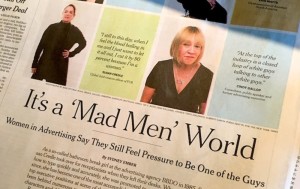 A male publicist recently asked if I thought gender bias had changed in any way since the Sixties, the Mad Men era in which I began my career as an art director. My answer was that I didn’t really think so. I believe an attitude of male superiority is still pervasive and although it may not be expressed as openly or as crassly as it was then, sexism still exists and, in many cases, is poorly concealed.
A male publicist recently asked if I thought gender bias had changed in any way since the Sixties, the Mad Men era in which I began my career as an art director. My answer was that I didn’t really think so. I believe an attitude of male superiority is still pervasive and although it may not be expressed as openly or as crassly as it was then, sexism still exists and, in many cases, is poorly concealed.
Just a few days later, the New York Times published, “For Women in Advertising, It’s Still a ‘Mad Men’ World,” in which a dozen current industry executives (mostly women) confirmed that “gender bias, while often unspoken or acknowledged, continues to affect how [women] are treated at work, whom they interact with and what positions they hold.”
When I came to New York City in 1964, I found it frustrating that I was unable to find a job in an art department of an advertising agency. (A recent graduate of Rhode Island School of Design, I was determined not to become a secretary.) I was given a variety of excuses, but the worst came from a senior partner of a large and prestigious ad agency who said they had never hired a girl because she would have to start in the bullpen and the boys would feel they couldn’t swear in front of her, and therefore their work would suffer. I was incredulous, but despite having read Betty Friedan, the word ‘discrimination’ never entered my mind. It was the way things were.
Blatant comments about women’s appearance were commonplace. At one magazine where I worked, the publisher would bring an advertiser by my desk and whisper, “Have a look at my art director,” as if I didn’t hear him. Not that it would have mattered; the concept of sexual harassment didn’t yet exist.
In the late seventies, I founded, and together with a female partner, ran a successful boutique advertising agency. Many years later, we merged with a larger agency that had an all-male hierarchy. It didn’t take long to realize that we’d been brought in as token female creative executives. I was invited to many meetings for which I was neither prepped nor had any reason to attend — except for the fact that I was female. The men stuck together and we were generally ignored, except when needed for display or a photo shoot that no one else wanted to handle. By this time (it was the 1990s) sexual harassment was illegal, but traditional attitudes hadn’t necessarily changed. One older copywriter, who frequently stopped by my office, used to comment in a seductive voice, “You’re harassing me just by being here.”
As I gained experience and seniority, I was treated with more respect; in fact, some of my male bosses were very supportive and treated me equally to men in the same position—in importance, if not in salary. And yet, while interacting with the men who became my clients, there was still too often an insinuation of seduction. After all, I was a woman in charge and many men held that as a challenge. One client called me after a meeting complaining his company hadn’t gotten the answer they wanted from my publisher because I wasn’t wearing a bra. (I was.) He then proceeded to ask me out. (I said no.)
While I had suspected as much, it was disappointing to have Sydney Ember’s Times piece confirm that on some level, the tenor of Madison Avenue hasn’t significantly changed in the years since I left. One-quarter of women working in advertising report having personally experienced gender discrimination, and nearly as many have experienced or witnessed sexual harassment. While women advance to executive roles more readily than they did in the time of Mad Men — as a female art director in the 1960s and ’70s, I was an anomaly — they currently comprise only 11% of creative directors. Demeaning and dismissive attitudes are still prevalent, and those women who do succeed must learn to cope, much as I did decades ago.
“The truth is,” Wendy Clark, chief executive of DDB North America, told Ember, “those of us who have made it through — you become impervious to it in some way.” Yes, it’s still a Mad Men world.
[…] and the related resignations of high-profile executives were front-page news a couple of times last spring, and again in the fall. Yet these stories continue to strike people as surprising. In truth, they […]